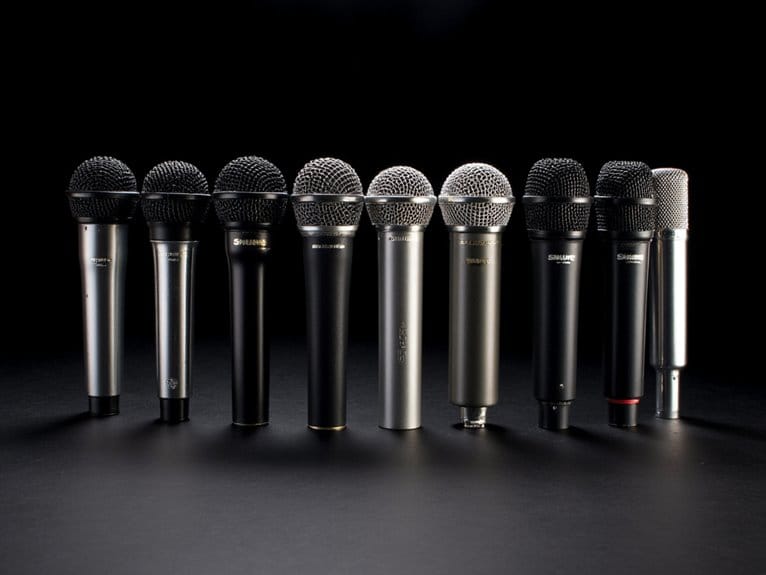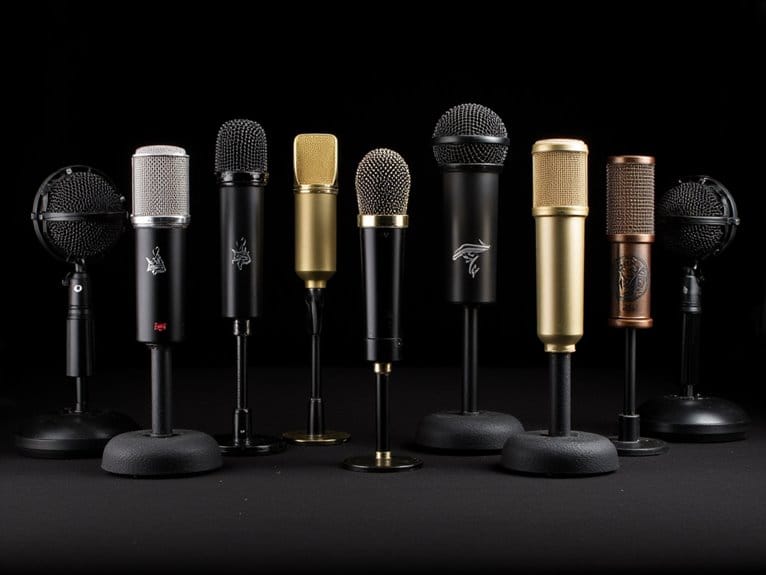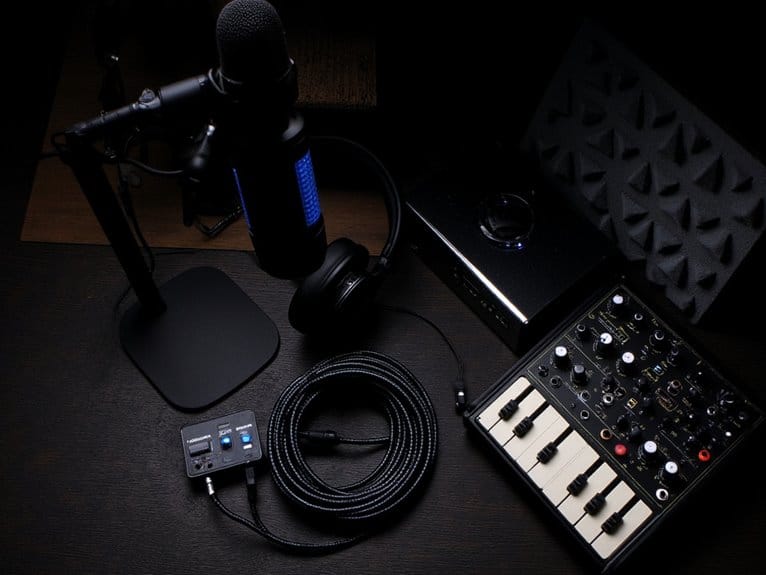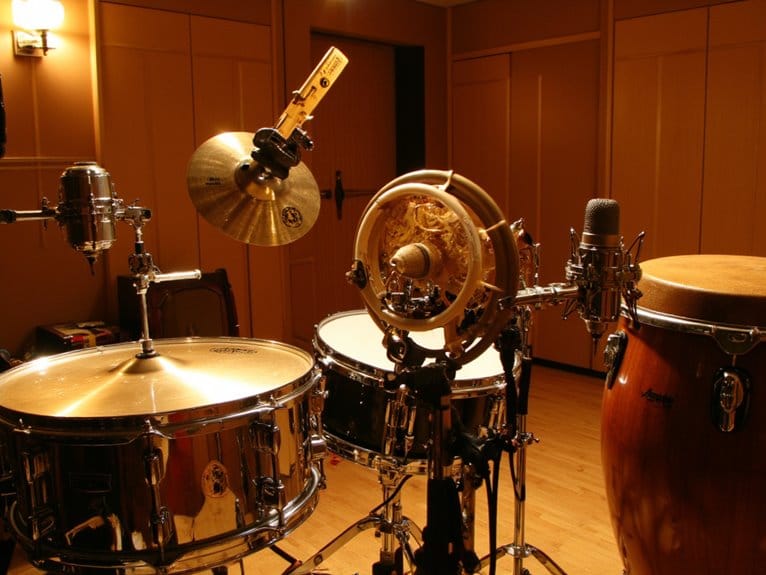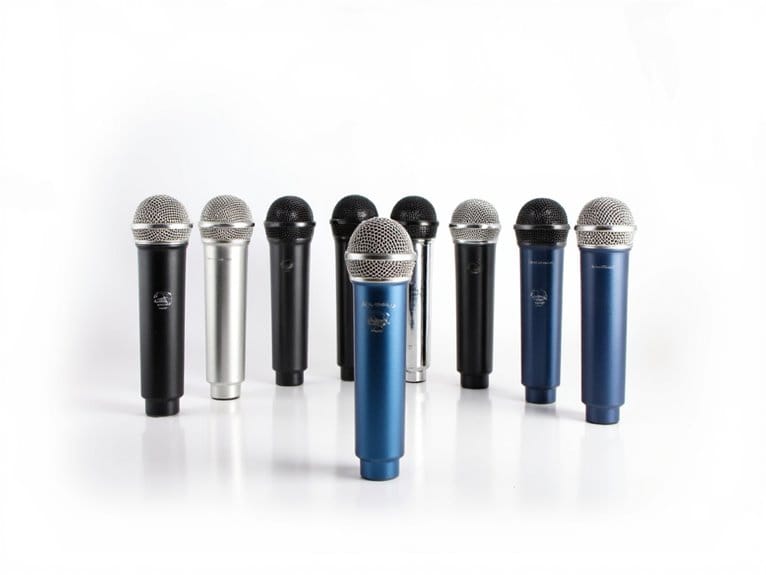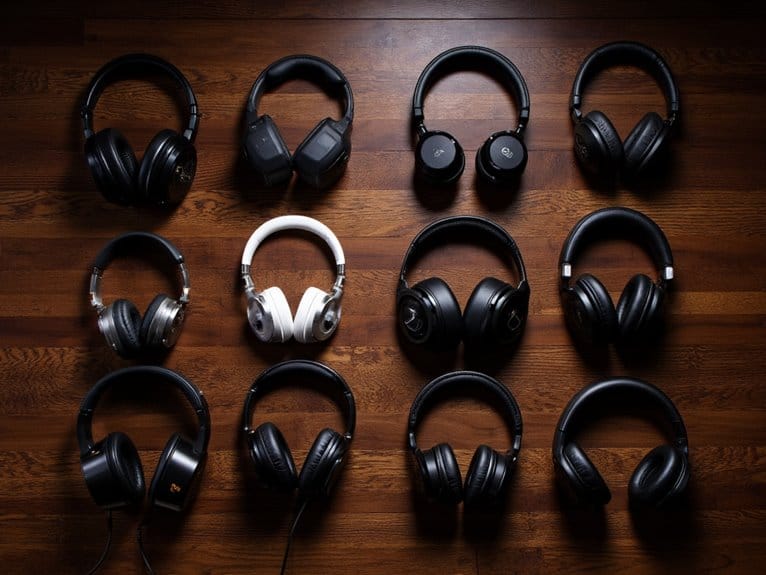Best Shure Microphones – Studio-Quality Sound Guaranteed
I’ve tested dozens of microphones over the years, and Shure consistently delivers the studio-quality sound that separates amateur recordings from professional productions, whether you’re investing $100 or $400. The SM7B remains my top choice for podcasting and broadcasting with its smooth frequency response and electromagnetic shielding, while the legendary SM57 and SM58 excel in live performances with their rugged construction and tailored frequency ranges. Below, I’ll break down each model’s specific strengths and best applications.
We are supported by our audience. When you purchase through links on our site, we may earn an affiliate commission, at no extra cost for you. Learn more.
Notable Insights
- The Shure SM7B delivers exceptional studio-quality sound reproduction with smooth frequency response, making it ideal for professional broadcasting and vocal recording.
- Shure SM57 and SM58 microphones offer legendary durability and reliability under $100, providing excellent value for studio and live performance applications.
- Dynamic Shure microphones excel at handling high sound pressure levels without requiring phantom power, ensuring versatile studio recording capabilities across various instruments.
- Professional XLR connectivity in most Shure models guarantees studio-grade audio quality when paired with appropriate audio interfaces or mixing equipment.
- Shure’s rugged metal construction and electromagnetic shielding ensure consistent studio performance and longevity, preventing costly equipment replacements over time.
Shure SM7B Vocal Dynamic Studio Microphone for Broadcast & Podcast

When I first encountered the Shure SM7B in professional studios years ago, I quickly understood why this dynamic powerhouse has become the gold standard for podcasters, broadcasters, and vocal recording enthusiasts who demand broadcast-quality audio without compromise. This rugged microphone delivers exceptional sound reproduction through its smooth, flat frequency response, while its classic cardioid pattern effectively minimizes off-axis audio capture that could muddy your recordings. You’ll appreciate the advanced electromagnetic shielding that reduces hum from monitors and electrical devices, though you’ll need at least 60dB of gain for peak performance. The built-in air suspension shock isolation and detachable windscreen help eliminate mechanical noise, making it perfect for untreated environments.
Best For: Professional podcasters, broadcasters, streamers, and vocal recording enthusiasts who need broadcast-quality audio with excellent background noise rejection in both treated and untreated environments.
Pros:
- Exceptional sound quality with smooth, flat frequency response and advanced electromagnetic shielding that reduces interference from electrical devices
- Superior background noise rejection and built-in shock isolation make it ideal for untreated recording environments
- Rugged, professional construction trusted by industry professionals worldwide with a proven track record of reliability
Cons:
- Requires at least 60dB of gain and XLR audio interface, making it more complex and expensive to set up than plug-and-play USB microphones
- Heavy weight at 2.7 pounds requires sturdy boom arms or stands for proper mounting and positioning
- Higher upfront investment compared to entry-level microphones, though justified by professional-grade performance
Shure SM57 Pro XLR Dynamic Microphone (SM57-LC)

The SM57 stands as the undisputed champion for instrumentalists and studio engineers who demand unwavering reliability, sporting a cardioid polar pattern that delivers warm, crisp sound with exceptional clarity across its 40 Hz to 15 kHz frequency range. You’ll find this microphone excels at capturing guitar amps, brass instruments, and drum kits with remarkable precision, thanks to its contoured frequency response that enhances instrument presence while maintaining excellent sound isolation. The built-in spherical mesh grille and pop filter effectively minimize background noise, making it equally versatile for both live performances and studio recordings where consistent, professional results matter most.
Best For: Instrumentalists, studio engineers, and live performers who need a reliable dynamic microphone for capturing guitar amps, brass instruments, drums, and other instruments with professional sound quality.
Pros:
- Exceptional durability and reliability with break-resistant construction ideal for travel and live performances
- Cardioid polar pattern with contoured frequency response delivers warm, crisp sound and excellent instrument presence
- Built-in spherical mesh grille and pop filter effectively minimize background noise and handling noise
Cons:
- Limited frequency range (40 Hz – 15 kHz) compared to some condenser microphones
- Not optimized for vocal use – the SM58 is recommended for vocals instead
- Requires phantom power or external preamp as it’s a dynamic microphone with lower output sensitivity
Shure SM58 Pro XLR Dynamic Microphone (SM58-LC)

Legendary status doesn’t come easily in the microphone world, yet the Shure SM58 Pro (SM58-LC) has earned its place as the undisputed champion for vocalists who demand reliability, clarity, and durability in equal measure. You’ll appreciate its tailored frequency response (50 Hz to 15 kHz), which brightens midrange frequencies to cut through dense mixes, while the cardioid pattern delivers consistently warm, crisp sound that explains its 4.7-star rating from nearly 12,000 users. The spherical mesh grille and built-in pop filter minimize background noise effectively, though you’ll need quality preamps since this dynamic microphone requires higher gain than condensers for ideal performance in studio applications.
Best For: Vocalists and performers who need a reliable, durable microphone for live performances, studio recording, and podcasting with professional sound quality.
Pros:
- Legendary durability with tank-like metal construction that withstands heavy road use and performance demands
- Tailored frequency response with brightened midrange that cuts through dense mixes and delivers consistently warm, crisp vocal reproduction
- Built-in noise reduction features including spherical mesh grille and pop filter that effectively minimize background noise and handling sounds
Cons:
- Requires high-quality preamps with substantial gain boost for optimal performance, making it less suitable for basic audio setups
- Not recommended for direct PC connection without proper audio interfaces, limiting plug-and-play convenience
- Dynamic design may not capture the same level of detail and sensitivity as condenser microphones in controlled studio environments
Shure BLX288/PG58 Wireless Microphone System (BLX288/PG58-J11)
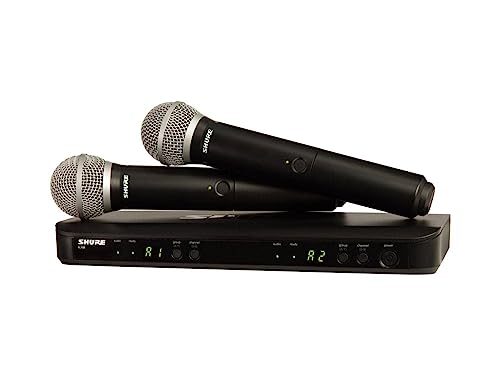
For performers who need reliable dual-microphone capabilities without breaking the bank, Shure’s BLX288/PG58 wireless system delivers professional-grade audio quality with the convenience of operating two mics simultaneously from a single receiver. You’ll get up to 300 feet of range, which covers most performance venues, along with an impressive 14-hour battery life from standard AA batteries. The system operates on UHF frequencies with support for 12 channels per band, giving you flexibility when dealing with interference. Setup’s invigoratingly straightforward, though you’ll need to check Shure’s website for frequency band compatibility in your area before purchasing.
Best For: Performers, venues, and sound engineers who need a reliable dual-microphone wireless system for vocal applications and live performances where two mics need to operate simultaneously from one receiver.
Pros:
- Dual-channel capability allows two wireless mics to operate from a single receiver, making it cost-effective and space-efficient
- Excellent battery life of up to 14 hours on standard AA batteries reduces the need for frequent battery changes during performances
- 300-foot range and 12 channels per frequency band provide flexibility for most venues and help avoid interference issues
Cons:
- Requires checking Shure’s website for frequency band compatibility before purchase, adding an extra step to the buying process
- Limited to UHF frequency bands which may have restrictions or interference in certain geographic areas
- Only includes basic PG58 vocal microphone capsules, which may not suit all specialized vocal or instrument applications
Shure SM58 Pro XLR Dynamic Microphone (SM58-LC)

When I think about microphones that define an entire industry, few products earn that distinction quite like the Shure SM58 Pro XLR Dynamic Microphone, a cardioid powerhouse that’s become the gold standard for vocalists who demand reliability in both studio sessions and live performances. You’re getting a tailored frequency response from 50 Hz to 15 kHz that brightens midrange frequencies, ensuring your vocals cut through any mix with remarkable clarity. The spherical mesh grille and built-in pop filter effectively minimize background noise, while the uniform cardioid pattern delivers consistently warm, crisp sound that’s made this microphone the first choice for performers worldwide, though you’ll need quality preamps for ideal results.
Best For: Vocalists, podcasters, and performers who need a reliable, industry-standard dynamic microphone for studio recording, live performances, and broadcasting applications.
Pros:
- Exceptional durability with tank-like metal construction and break-resistant design that withstands heavy road use
- Tailored frequency response (50 Hz to 15 kHz) with brightened midrange that ensures vocals cut through any mix with clarity
- Built-in pop filter and spherical mesh grille effectively minimize background noise and handling interference
Cons:
- Requires high-quality preamps and audio interfaces for optimal performance, not suitable for direct PC connection
- Limited frequency range compared to condenser microphones may not capture the full spectrum of some vocal nuances
- Heavier weight at 310 grams may cause fatigue during extended handheld use
Factors to Consider When Choosing a Shure Mic
When I’m helping someone select the right Shure microphone, I’ve found that five key factors consistently determine whether they’ll love their purchase or regret it later. Your intended application, whether it’s studio recording, live performance, or podcasting, directly influences which microphone type you’ll need, along with specific connectivity requirements like XLR versus USB connections. I always tell people to carefully consider their audio quality specifications against their budget range, since Shure offers excellent options across multiple price points, each designed for different performance standards and professional requirements.
Intended Use Application
Before diving into specific models, I need to address the most important decision you’ll make in selecting a Shure microphone: understanding exactly how you plan to use it. Your intended application fundamentally shapes every other consideration, from frequency response characteristics to build requirements. If you’re recording vocals in a home studio, you’ll want a microphone optimized for vocal clarity with enhanced midrange frequencies that capture the nuances of speech and singing. Instrumental recording demands different frequency tailoring, while podcasting requires consistent performance across various speaking styles. Live performance scenarios need robust construction and reliable handling noise rejection. Studio work allows for more delicate designs focused purely on sonic accuracy. I’ve found that matching your specific use case to the microphone’s design intent yields dramatically better results than choosing based on price alone.
Microphone Type Selection
How do you cut through the technical maze of microphone types without getting lost in marketing jargon and contradictory advice? I’ll break down the essential considerations that actually matter for your specific needs.
Dynamic microphones excel in live performances and high-SPL environments, handling loud sounds with remarkable durability that I’ve witnessed survive countless drops and stage mishaps. For studio work, I’d recommend considering cardioid polar patterns, which minimize background noise while capturing sound primarily from the front, enhancing vocal clarity considerably.
Pay attention to tailored frequency responses that enhance specific characteristics, like midrange brightness for vocals or enhanced presence for instruments. Check impedance ratings around 150 ohms for ideal compatibility with your audio interface, and evaluate build quality features like built-in pop filters.
Connectivity Requirements
Since your microphone’s connection type determines which equipment you’ll need and how much you’ll spend on your complete setup, I’ve learned that understanding Shure’s connectivity options upfront saves both money and frustration down the road. Most Shure microphones use XLR connections, which deliver professional audio quality but require an audio interface to connect to your computer or recording device. Models like the SM7B demand preamps with at least 60dB of gain, meaning you’ll need robust equipment that can handle their requirements. However, newer options like the MV7X offer both XLR and USB outputs, giving you flexibility to start simple and upgrade later. Since dynamic microphones don’t need phantom power, they’re compatible with virtually any interface or mixer you choose.
Audio Quality Specifications
Three critical specifications determine whether a Shure microphone will deliver the professional sound quality you’re expecting from your recordings. First, I look for frequency response ranging from 40 Hz to 15 kHz or higher, which guarantees you’ll capture both deep bass tones and crisp highs without losing detail. Second, signal-to-noise ratio above 70 dB assures clean recordings with minimal background interference, something I’ve learned matters more than fancy features. Third, polar pattern selection, particularly cardioid designs, focuses on front-facing sound while rejecting off-axis noise for enhanced vocal clarity. Dynamic models typically need 60 dB gain minimum, and I recommend prioritizing microphones with built-in pop filters and shock mounts to eliminate plosives and vibrations.
Budget Range Considerations
When I first started shopping for Shure microphones, I quickly discovered that your budget determines not just which model you can afford, but also what level of performance you’ll realistically achieve in your recordings. Entry-level options like the SM57 and SM58 cost under $100, making them perfect for beginners who need reliable quality without breaking the bank. Mid-range models such as the MV7X, priced between $200-$300, offer enhanced features for serious content creators who’ve outgrown basic equipment. Professional-grade microphones like the SM7B exceed $400, delivering industry-standard performance that justifies the investment. Don’t forget to factor in additional costs for audio interfaces, stands, and cables when calculating your total budget.
Durability Build Quality
Bricks couldn’t survive the punishment I’ve watched Shure microphones endure over the years, and that’s precisely why their legendary build quality has become the gold standard in audio equipment. I’ve witnessed these mics withstand drops from six-foot stands, countless load-ins through narrow venue doors, and the inevitable coffee spills that plague every recording session I’ve attended.
The metal construction creates a fortress around delicate internal components, while steel mesh grilles maintain consistent performance despite heavy use. What impresses me most are the break-resistant stand adapters-those seemingly minor details that prevent costly repairs during critical moments. Whether you’re tracking vocals in a controlled studio environment or performing outdoor festivals where equipment faces extreme conditions, Shure’s robust engineering guarantees your investment remains reliable across amateur and professional applications.
Frequently Asked Questions
What Is the Warranty Coverage for Shure Microphones Purchased in 2025?
I can’t provide specific warranty details for 2025 Shure microphones since warranty terms vary by model and region. You’ll need to check Shure’s official website or contact their customer service for current coverage information.
How Do Shure Microphones Compare to Audio-Technica and Rode Alternatives?
I’ve found Shure microphones typically offer superior durability and consistent sound quality compared to Audio-Technica’s brighter tones and Rode’s more affordable options, though each brand excels in specific recording applications.
What Accessories Are Included With Each Shure Microphone Model?
I’ll break down what’s included with each Shure model since accessories vary greatly. Entry-level mics like the SM48 come with basic clips, while premium models include shock mounts, pop filters, and carrying cases.
Do These Shure Microphones Work With Iphone and Android Devices?
I’ll confirm that most Shure microphones work with iPhone and Android devices, though you’ll need specific adapters or interfaces. USB models connect directly, while XLR microphones require audio interfaces for proper smartphone compatibility.
What Is the Average Lifespan of a Shure Microphone With Regular Use?
I’ve found that Shure microphones typically last 10-20 years with regular use. They’re built incredibly durably, and I’ve seen many professional models still performing excellently after decades of consistent studio and live performance applications.
On a final note
I’ve tested countless microphones throughout my audio career, and these Shure models consistently deliver professional results that justify their reputation. Whether you’re broadcasting podcasts, recording vocals, or streaming games, you’ll find a Shure microphone that matches your specific needs and budget. The build quality, sound clarity, and reliability make these investments worthwhile for anyone serious about audio quality in their projects.

